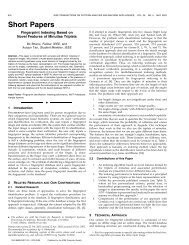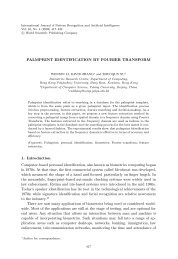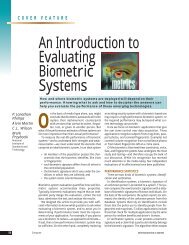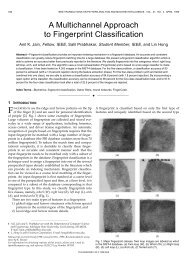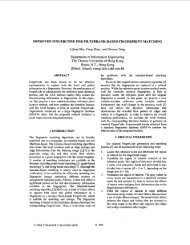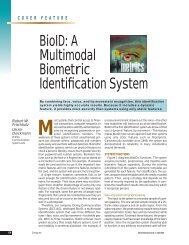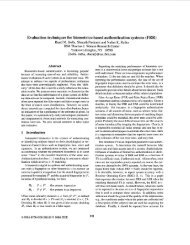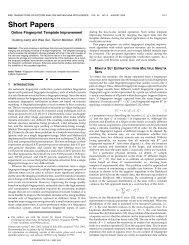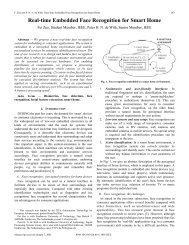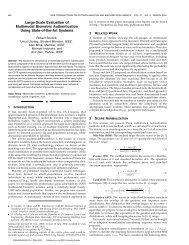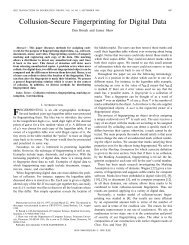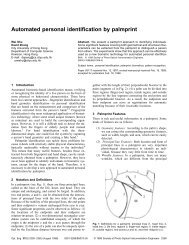A fingerprint verification system based on triangular matching and ...
A fingerprint verification system based on triangular matching and ...
A fingerprint verification system based on triangular matching and ...
- No tags were found...
You also want an ePaper? Increase the reach of your titles
YUMPU automatically turns print PDFs into web optimized ePapers that Google loves.
KOV ACS-VAJNA: A FINGERPRINT VERIFICATION SYSTEM BASED ON TRIANGULAR MATCHING AND DYNAMIC TIME WARPING 1267reference minutiae regi<strong>on</strong>s <strong>and</strong> the test image. If somecorresp<strong>on</strong>dences are found, a <strong>triangular</strong> <strong>matching</strong> is applied<strong>and</strong> a possible <str<strong>on</strong>g>fingerprint</str<strong>on</strong>g> <strong>matching</strong> is defined. Finally, thistentative <strong>matching</strong> has to be verified by Dynamic TimeWarping [11] to overcome the str<strong>on</strong>g local deformati<strong>on</strong>s. Thislatter <str<strong>on</strong>g>verificati<strong>on</strong></str<strong>on</strong>g> step corresp<strong>on</strong>ds to the ridge countrequired by a legal <str<strong>on</strong>g>fingerprint</str<strong>on</strong>g> <str<strong>on</strong>g>verificati<strong>on</strong></str<strong>on</strong>g> [3].2.1 Informati<strong>on</strong> Extracti<strong>on</strong> BlockThe procedures of this block are applied to the referenceimage <strong>on</strong>ly. The main result of this processing is the realminutiae set of the <str<strong>on</strong>g>fingerprint</str<strong>on</strong>g>, minimizing the false minutiae<strong>and</strong> maximizing the true <strong>on</strong>es.Fig. 1. Flow-chart of the identificati<strong>on</strong> <str<strong>on</strong>g>system</str<strong>on</strong>g>.database c<strong>on</strong>taining severely deformed <strong>and</strong> difficultimages. Some c<strong>on</strong>clusi<strong>on</strong>s end the paper.2 THE SYSTEMFig. 1 shows the block-diagram of the <str<strong>on</strong>g>fingerprint</str<strong>on</strong>g> <strong>matching</strong><str<strong>on</strong>g>system</str<strong>on</strong>g>. The <str<strong>on</strong>g>system</str<strong>on</strong>g> compares two <str<strong>on</strong>g>fingerprint</str<strong>on</strong>g> images: areference image <strong>and</strong> a test image. It is assumed that areference image is available for the pers<strong>on</strong> to be identified<strong>and</strong> that it may be processed offline. The test image isobtained <strong>and</strong> used in real-time. It has to be compared to thereference image within a short time compatible with theapplicati<strong>on</strong>.The operati<strong>on</strong> sequence applied to the reference image isshown in the ªInformati<strong>on</strong> Extracti<strong>on</strong> Blockº <strong>and</strong> theeffective <str<strong>on</strong>g>fingerprint</str<strong>on</strong>g> <strong>matching</strong> is carried out <strong>on</strong> each testimage, as shown in the ªMatching Block.º The referenceimage is carefully filtered to reduce noise <strong>and</strong> to use thewhole gray-scale dynamics. Since this operati<strong>on</strong> is performed<strong>on</strong>ly <strong>on</strong>ce for each pers<strong>on</strong> to be identified, thefiltering operati<strong>on</strong> speed is not a primary requirement.Minutiae detecti<strong>on</strong> follows. Thanks to the high-qualityimage, the false minutiae at this point are less than 10 percentof the extracted minutiae [9]. The minutiae coordinates <strong>and</strong>the neighboring minutiae list is extracted for each detectedminutiae. A coarse <strong>and</strong> fast filter is applied to the originalreference image <strong>and</strong> the regi<strong>on</strong> of 16 16 pixels aroundeach minutiae point is saved in several rotated versi<strong>on</strong>s tocope with a possible significant global rotati<strong>on</strong>.The test image is acquired by the same device as thereference image. It is filtered by the same coarse filter appliedto the reference image leading to comparable images. Thefiltered test image is scanned by a moving window technique[10] searching for possible corresp<strong>on</strong>dences between the2.1.1 Fine <strong>and</strong> Coarse FilteringTwo different filters are applied to the reference image: afine <strong>and</strong> a coarse <strong>on</strong>e. The test image will be <strong>on</strong>ly coarselyfiltered due to the time c<strong>on</strong>straints.The fine filter should reduce the noise as much aspossible to facilitate the subsequent minutiae extracti<strong>on</strong>operati<strong>on</strong>s. The specific filter used in this work is the <strong>on</strong>eemployed in the PCASYS package [12] built by researchersat NIST. The filter is <str<strong>on</strong>g>based</str<strong>on</strong>g> <strong>on</strong> the bidimensi<strong>on</strong>alFourier transform <strong>and</strong> some n<strong>on</strong>linear operators in thefrequency domain in order to reduce low <strong>and</strong> highfrequency noise. This specific filter was successfullyapplied both to paper-scanned images [8] <strong>and</strong> to thoseacquired by a capacitive sensor [6]. In Fig. 2, a paperscannedimage is shown <strong>on</strong> the left <strong>and</strong> the corresp<strong>on</strong>dingfine-filtered image is shown in the center.The image quality is improved by the coarse filteringprocedure, exp<strong>and</strong>ing the gray-scale dynamics to the wholepixel depth. There are several reas<strong>on</strong>s why the <str<strong>on</strong>g>fingerprint</str<strong>on</strong>g>image does not cover the whole gray-scale dynamics:insufficient c<strong>on</strong>trast or illuminati<strong>on</strong>, uneven ink distributi<strong>on</strong><strong>on</strong> the paper, shallow valleys, dirty fingertips,humidity, etc. When different gray-scale images arecompared, some with str<strong>on</strong>g c<strong>on</strong>trast <strong>and</strong> some without, itis very useful to equalize the signal amplitude, which in thiscase is the gray value. The coarse filter does not cope withthe noise in the frequency domain nor with ridge or valleyinterrupti<strong>on</strong>s. Since this filter is applied both <strong>on</strong> thereference <strong>and</strong> test images, it has to be fast <strong>and</strong> thereforesimple. The coarse filtering procedure c<strong>on</strong>sists of thesubsequent steps:1. A four-neighbor average filter is applied to eachpixel in the image to blur the image, reducing sharplocal variati<strong>on</strong>s.2. The image is split into m n regi<strong>on</strong>s, creatingapproximately 16 16 pixel squares.3. The average, maximum, <strong>and</strong> minimum pixel valuesare computed for each regi<strong>on</strong>.4. A four-neighbor average filter is used to equalize theaverage, maximum, <strong>and</strong> minimum pixel values ofthe whole image.5. The new pixel value is computed for each point inthe image according to the formula:



